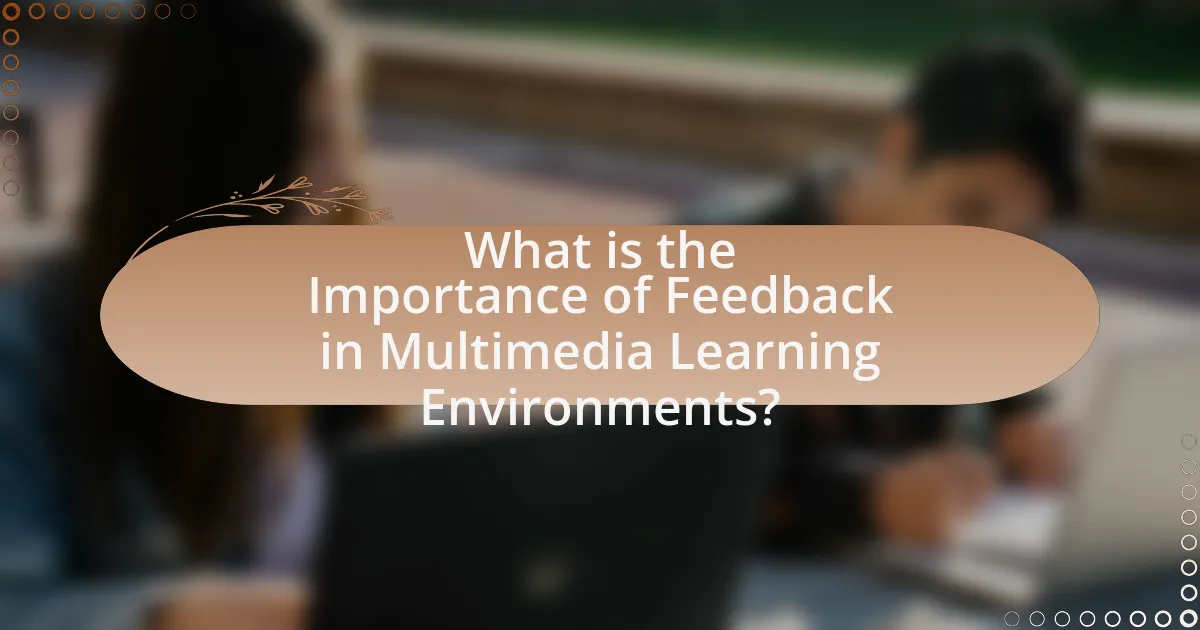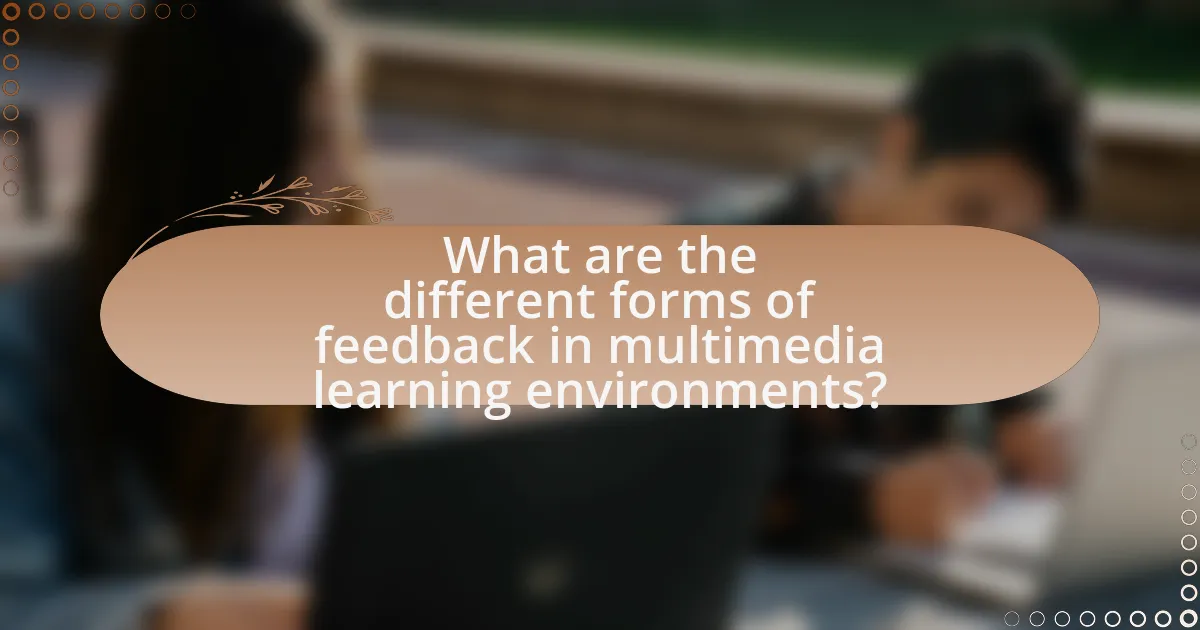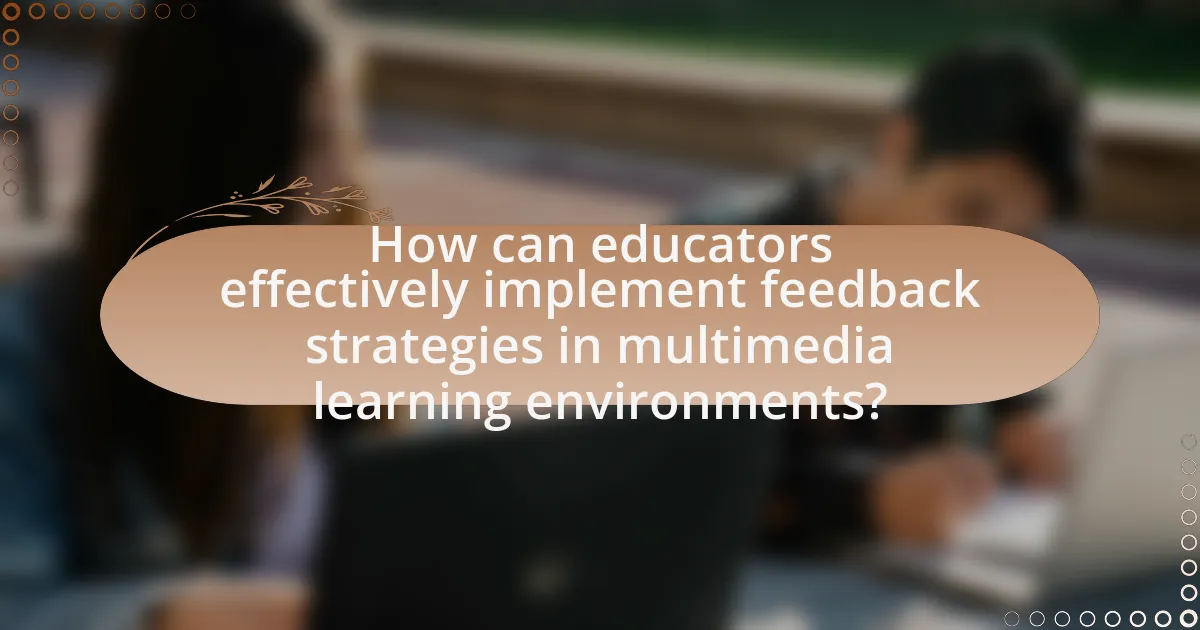The article focuses on the significance of feedback in multimedia learning environments, highlighting its role in enhancing learner engagement, knowledge retention, and motivation. It discusses various types of feedback, including immediate and formative feedback, and their impact on learning outcomes. The article also examines how feedback fosters self-regulated learning, promotes a growth mindset, and can be effectively implemented through technological tools and best practices. Additionally, it addresses common pitfalls in providing feedback and emphasizes the implications of feedback on learner satisfaction and performance.

What is the Importance of Feedback in Multimedia Learning Environments?
Feedback is crucial in multimedia learning environments as it enhances learner engagement and improves knowledge retention. Effective feedback provides learners with specific information about their performance, allowing them to identify strengths and areas for improvement. Research indicates that timely and constructive feedback can lead to a 20% increase in learning outcomes, as it helps learners adjust their strategies and deepen their understanding of the material. Additionally, feedback fosters a sense of accountability and motivation, encouraging learners to take an active role in their education.
How does feedback enhance the learning experience in multimedia settings?
Feedback enhances the learning experience in multimedia settings by providing learners with specific, actionable insights that guide their understanding and improve their performance. In multimedia environments, feedback can be immediate and tailored, allowing learners to adjust their strategies and approaches in real-time. Research indicates that timely feedback significantly increases retention rates and engagement, as evidenced by a study published in the Journal of Educational Psychology, which found that students receiving immediate feedback scored 20% higher on assessments compared to those who did not receive feedback. This demonstrates that effective feedback mechanisms in multimedia settings not only clarify misconceptions but also foster a more interactive and personalized learning experience.
What types of feedback are most effective in multimedia learning?
Immediate feedback and formative feedback are the most effective types of feedback in multimedia learning. Immediate feedback provides learners with instant responses to their actions, allowing them to correct mistakes and reinforce learning in real-time. Formative feedback, on the other hand, focuses on guiding learners through the learning process by offering constructive suggestions and insights that help them improve over time. Research by Hattie and Timperley (2007) indicates that feedback that is specific, timely, and actionable significantly enhances learning outcomes. This evidence supports the effectiveness of both immediate and formative feedback in multimedia learning environments.
How does immediate feedback impact learner engagement?
Immediate feedback significantly enhances learner engagement by providing timely information that helps students understand their performance and correct mistakes. This real-time interaction fosters a sense of involvement and motivation, as learners can immediately apply corrections and see the results of their efforts. Research by Hattie and Timperley (2007) indicates that feedback is one of the most powerful influences on learning outcomes, with immediate feedback being particularly effective in maintaining learner interest and participation. Furthermore, studies show that learners who receive prompt feedback are more likely to persist in challenging tasks, leading to deeper engagement and improved learning experiences.
Why is feedback crucial for learner motivation in multimedia environments?
Feedback is crucial for learner motivation in multimedia environments because it provides immediate reinforcement and guidance, helping learners understand their progress and areas for improvement. In multimedia learning, where diverse formats such as videos, interactive simulations, and quizzes are used, timely feedback enhances engagement by allowing learners to adjust their strategies and deepen their understanding. Research indicates that feedback can increase motivation by up to 30%, as it fosters a sense of achievement and encourages persistence in learning tasks. This is supported by studies showing that learners who receive constructive feedback are more likely to stay motivated and achieve better outcomes compared to those who do not receive feedback.
What role does feedback play in self-regulated learning?
Feedback plays a crucial role in self-regulated learning by providing learners with information about their performance, which helps them adjust their strategies and improve their understanding. This process enables learners to set goals, monitor their progress, and reflect on their learning outcomes. Research indicates that timely and specific feedback enhances motivation and self-efficacy, leading to better academic performance. For instance, a study by Hattie and Timperley (2007) in “Review of Educational Research” highlights that feedback is one of the most powerful influences on learning, emphasizing its importance in guiding learners toward achieving their educational objectives.
How can feedback foster a growth mindset among learners?
Feedback fosters a growth mindset among learners by providing specific, constructive insights that encourage improvement and resilience. When learners receive feedback, they understand their strengths and areas for development, which promotes a belief in their ability to grow through effort and learning. Research by Dweck (2006) highlights that feedback emphasizing effort rather than innate ability leads to increased motivation and a willingness to embrace challenges. This aligns with the principles of a growth mindset, where learners view setbacks as opportunities for learning rather than failures. Thus, effective feedback not only informs learners about their progress but also reinforces the idea that skills can be developed through dedication and hard work.

What are the different forms of feedback in multimedia learning environments?
Different forms of feedback in multimedia learning environments include formative feedback, summative feedback, corrective feedback, and peer feedback. Formative feedback is provided during the learning process to help learners improve, while summative feedback evaluates learner performance at the end of an instructional unit. Corrective feedback addresses specific errors or misconceptions, guiding learners toward the correct understanding. Peer feedback involves input from fellow learners, fostering collaborative learning and diverse perspectives. Research indicates that effective feedback enhances learning outcomes by clarifying expectations and promoting self-regulation among learners.
How do formative and summative feedback differ in multimedia contexts?
Formative feedback in multimedia contexts is ongoing and aims to improve learning during the instructional process, while summative feedback evaluates learning outcomes after instruction has concluded. Formative feedback is typically provided through interactive elements such as quizzes, discussions, or real-time assessments, allowing learners to adjust their understanding and skills as they engage with the multimedia content. In contrast, summative feedback is often delivered through final assessments, projects, or evaluations that measure the overall effectiveness of the learning experience and the learner’s mastery of the material. Research indicates that formative feedback can significantly enhance learner engagement and retention, as it provides immediate insights for improvement, whereas summative feedback serves to validate learning achievements and inform future instructional design.
What are examples of formative feedback in multimedia learning?
Examples of formative feedback in multimedia learning include interactive quizzes that provide immediate scoring and explanations, peer reviews that allow learners to critique each other’s work, and adaptive learning systems that adjust content based on student performance. These methods enable learners to understand their strengths and weaknesses in real-time, facilitating a more personalized learning experience. Research indicates that immediate feedback can enhance retention and understanding, as demonstrated in studies such as those by Hattie and Timperley (2007), which emphasize the positive impact of timely feedback on learning outcomes.
How can summative feedback be effectively delivered in these environments?
Summative feedback can be effectively delivered in multimedia learning environments through structured assessments that utilize clear criteria and timely communication. Research indicates that providing specific, actionable feedback enhances learner understanding and retention, as evidenced by studies showing that students who receive detailed feedback perform better in subsequent assessments (Hattie & Timperley, 2007). Additionally, integrating multimedia elements, such as video or interactive components, can engage learners and clarify feedback, making it more impactful.
What technological tools facilitate feedback in multimedia learning?
Technological tools that facilitate feedback in multimedia learning include Learning Management Systems (LMS), interactive video platforms, and online assessment tools. LMS platforms like Moodle and Canvas allow educators to provide timely feedback on assignments and quizzes, enhancing the learning experience. Interactive video platforms, such as Edpuzzle, enable instructors to embed questions and comments directly into videos, allowing for immediate feedback. Online assessment tools, like Google Forms and Kahoot, provide instant results and analytics, helping learners understand their performance in real-time. These tools collectively enhance the feedback process, making it more efficient and effective in multimedia learning environments.
How do learning management systems support feedback mechanisms?
Learning management systems (LMS) support feedback mechanisms by providing tools for real-time assessment and communication between instructors and learners. These systems enable automated quizzes and assignments that deliver immediate feedback on performance, allowing learners to understand their strengths and areas for improvement. Additionally, LMS platforms often include features such as discussion forums and messaging systems, facilitating ongoing dialogue about course content and individual progress. Research indicates that timely feedback can enhance learning outcomes, as highlighted in studies showing that students who receive prompt feedback are more likely to engage with the material and improve their performance.
What role do interactive elements play in providing feedback?
Interactive elements play a crucial role in providing feedback by facilitating real-time responses that enhance learner engagement and understanding. These elements, such as quizzes, polls, and simulations, allow learners to receive immediate feedback on their performance, which reinforces learning and helps identify areas for improvement. Research indicates that immediate feedback can significantly increase retention rates and motivation, as evidenced by a study published in the Journal of Educational Psychology, which found that students who engaged with interactive feedback mechanisms scored 20% higher on assessments compared to those who did not. This demonstrates that interactive elements are essential in creating effective multimedia learning environments by promoting active participation and continuous improvement.

How can educators effectively implement feedback strategies in multimedia learning environments?
Educators can effectively implement feedback strategies in multimedia learning environments by utilizing timely, specific, and actionable feedback mechanisms. Research indicates that immediate feedback enhances learning outcomes, as it allows students to correct misunderstandings promptly (Hattie & Timperley, 2007). Additionally, incorporating various multimedia formats, such as video, audio, and interactive elements, can cater to diverse learning styles and reinforce the feedback provided. For instance, using video annotations can clarify complex concepts, while interactive quizzes can provide instant performance feedback. This multifaceted approach not only engages learners but also fosters a deeper understanding of the material, ultimately improving educational effectiveness.
What best practices should educators follow for delivering feedback?
Educators should provide timely, specific, and constructive feedback to enhance student learning. Timely feedback allows students to understand their performance while the material is still fresh, increasing the likelihood of improvement. Specific feedback focuses on particular aspects of student work, helping learners identify strengths and areas for growth. Constructive feedback encourages a growth mindset by highlighting how students can improve rather than merely pointing out mistakes. Research indicates that feedback that is clear and actionable can lead to a 30% increase in student performance (Hattie & Timperley, 2007). By adhering to these best practices, educators can significantly impact student engagement and learning outcomes in multimedia environments.
How can educators tailor feedback to meet diverse learner needs?
Educators can tailor feedback to meet diverse learner needs by employing differentiated feedback strategies that consider individual learning styles, preferences, and levels of understanding. For instance, using formative assessments allows educators to gather data on student performance and adjust their feedback accordingly, ensuring it is relevant and constructive. Research indicates that personalized feedback, which aligns with students’ specific goals and challenges, enhances motivation and learning outcomes. A study by Hattie and Timperley (2007) in “Review of Educational Research” highlights that feedback that is specific, timely, and actionable significantly improves student achievement, demonstrating the effectiveness of tailored feedback in addressing diverse learner needs.
What are common pitfalls to avoid when providing feedback?
Common pitfalls to avoid when providing feedback include being vague, focusing solely on negative aspects, and failing to tailor feedback to the recipient’s needs. Vague feedback lacks clarity, making it difficult for the recipient to understand what specific actions to take for improvement. Research indicates that feedback should be specific and actionable to enhance learning outcomes (Hattie & Timperley, 2007). Focusing only on negative aspects can demotivate individuals, leading to disengagement; balanced feedback that includes positive reinforcement is more effective. Additionally, failing to consider the recipient’s context and learning style can result in feedback that is not relevant or helpful, as effective feedback should be personalized to maximize its impact.
What are the implications of feedback on learner outcomes in multimedia environments?
Feedback significantly enhances learner outcomes in multimedia environments by providing timely information that guides learners’ understanding and performance. Research indicates that feedback can lead to improved retention of information, increased motivation, and better problem-solving skills. For instance, a study by Hattie and Timperley (2007) in “Review of Educational Research” found that feedback is one of the most powerful influences on student achievement, with effect sizes ranging from 0.4 to 0.7, indicating substantial positive impacts on learning. Additionally, feedback in multimedia settings can help learners identify gaps in their knowledge, allowing for targeted improvements and fostering a more personalized learning experience.
How does feedback influence knowledge retention in multimedia learning?
Feedback significantly enhances knowledge retention in multimedia learning by providing learners with immediate information about their performance, which helps to correct misunderstandings and reinforce correct concepts. Research indicates that timely feedback can lead to a 20% increase in retention rates, as it allows learners to engage in self-assessment and reflection, thereby solidifying their understanding. For instance, a study by Hattie and Timperley (2007) in “Review of Educational Research” highlights that feedback not only clarifies learning goals but also guides learners on how to improve, which directly contributes to better retention of knowledge in multimedia contexts.
What impact does feedback have on learner satisfaction and performance?
Feedback significantly enhances learner satisfaction and performance by providing essential information that guides improvement. Research indicates that timely and constructive feedback leads to higher engagement levels, as learners feel supported and informed about their progress. A study by Hattie and Timperley (2007) in “Review of Educational Research” found that feedback can increase student achievement by up to 30%. This demonstrates that effective feedback not only boosts satisfaction but also directly correlates with improved academic outcomes.
What practical tips can enhance the effectiveness of feedback in multimedia learning environments?
To enhance the effectiveness of feedback in multimedia learning environments, it is essential to provide timely, specific, and actionable feedback. Timely feedback ensures that learners can immediately apply the insights to their ongoing tasks, which has been shown to improve retention and understanding. Specific feedback focuses on particular aspects of performance, allowing learners to identify strengths and areas for improvement, which is supported by research indicating that detailed feedback leads to better learning outcomes. Actionable feedback gives clear steps for improvement, enabling learners to make concrete changes in their approach. Studies have demonstrated that feedback that includes these elements significantly boosts learner engagement and achievement in multimedia contexts.